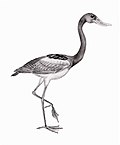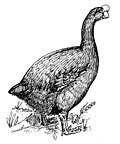
Anseriformes is an order of birds also known as waterfowl that comprises about 180 living species of birds in three families: Anhimidae, Anseranatidae, and Anatidae, the largest family, which includes over 170 species of waterfowl, among them the ducks, geese, and swans. Most modern species in the order are highly adapted for an aquatic existence at the water surface. With the exception of screamers, males have penises, a trait that has been lost in the Neoaves, the clade consisting of all other modern birds except the galliformes and paleognaths. Due to their aquatic nature, most species are web-footed.

The order Peramelemorphia includes the bandicoots and bilbies. All members of the order are endemic to Australia-New Guinea and most have the characteristic bandicoot shape: a plump, arch-backed body with a long, delicately tapering snout, very large upright ears, relatively long, thin legs, and a thin tail. Their size varies from about 140 grams up to 4 kilograms, but most species are about one kilogram.

The magpie goose is the sole living representative species of the family Anseranatidae. This common waterbird is found in northern Australia and southern New Guinea. As the species is prone to wandering, especially when not breeding, it is sometimes recorded outside its core range. The species was once also widespread in southern Australia but disappeared from there largely due to the drainage of the wetlands where the birds once bred. Due to their importance to Aboriginal people as a seasonal food source, as subjects of recreational hunting, and as a tourist attraction, their expansive and stable presence in northern Australia has been "ensured [by] protective management".

Anseranatidae, the magpie-geese, is a biological family of waterbirds. The only living species, the magpie goose, is a resident breeder in northern Australia and in southern New Guinea.
Barawertornis tedfordi was a dromornithid (mihirung), a large flightless fowl hailing from Late Oligocene to Early Miocene. The only species in the genus Barawertornis, its fossil remains are found in strata of the Riversleigh deposits located at two sites in Northwestern Queensland, Australia.
Pengana, also referred to as flexiraptor, is an extinct bird of prey that lived during the late Oligocene in what is now Queensland, Australia. It is known only from a fragment of the tibiotarsus that was collected from the Riversleigh World Heritage Area. The tibiotarsus is unusual in that it allowed for the leg to be swivelled backwards and sideways, making it well adapted to reaching into holes and crevices and extracting prey. The genus is only known from a single species, Pengana robertbolesi.

The genus Nimbacinus contains two species of carnivorous, quadrupedal marsupials in Australia both of which are extinct:
Anatalavis is genus of prehistoric birds related to ducks and geese, perhaps to the magpie-goose in particular. Alternatively, it might have been a more basal lineage of Anserimorphae distinct from the living waterfowl, similar or even related to the roughly contemporary Conflicto antarcticus from the Danian of Antarctica.

Muribacinus is an extinct genus of thylacinid that lived during the middle Miocene in what is now northwestern Queensland, Australia. It was described in 1995 from remains collected at the Riversleigh World Heritage Area. Only one species is known, M. gadiyuli.

Ngamalacinus is an extinct genus of thylacinid that lived in Australia from about 26 to 16 million years ago. Its fossils are solely known from the Riversleigh World Heritage Area in Queensland. Two species are currently known, the Early Miocene N. timmulvaneyi and the Late Oligocene N. nigelmarveni. In appearance it resembled a dog with a long snout. Its molar teeth were specialized for carnivory, the cups and crest were reduced or elongated to give the molars a cutting blade.
Wabulacinus is a poorly known genus of thylacinid marsupial from Early Miocene and possibly Late Oligocene deposits at the Riversleigh World Heritage Area in Queensland. It consists of two species, the type species W. ridei and W. macknessi. The snout of W. ridei was relatively broad, while W. macknessi had a noticeably elongated skull. Both species are thought to have been hypercarnivorous.
Ganguroo is a genus of fossil macropods found at Riversleigh in Australia, material dating from the Middle to Late Miocene Epoch. The type species of the genus is Ganguroo bilamina, published in 1997. Two recently described species, Ganguroo bites and Ganguroo robustiter, have also been placed in this genus.
Naraboryctes philcreaseri is a fossil species of marsupial found at early Miocene deposits of Boodjamulla National Park of Riversleigh area, northwestern Queensland, Australia.
Priscakoala is an extinct genus of koala from the Early Miocene of Riversleigh, Australia. It has one species: Priscakoala lucyturnbullae.
Cookeroo is a genus of extinct kangaroos from the Late Oligocene and Early Miocene found in fossil deposits from the Riversleigh World Heritage Area, in Australia. The genus includes two species, C. bulwidarri and C. hortusensis.
Suzanne J. Hand is Professor Emeritus at the University of New South Wales, a teacher of geology and biology, who has a special interest in vertebrate palaeontology and modern mammals. Her research has been published in over 250 articles and books, and is especially focused on the subjects of evolutionary biology, functional morphology, phylogenetics, and biogeography. Hand is a co-leader of the research team investigating the Riversleigh World Heritage Area, regarded as one of the four most important sites of fossil-bearing formations in the world.
Riversleigh fauna is the collective term for any species of animal identified in fossil sites located in the Riversleigh World Heritage Area.
Macroderma godthelpi is a species of bat known from fossil material found in Australia, one of the larger carnivorous megadermatid family of the order Chiroptera. They resembled the modern species Macroderma gigas, known as a false vampire or ghost bat, although significantly smaller than any other species of Macroderma.

Crash bandicoot is an extinct bandicoot, known from fossils located at the Riversleigh World Heritage Area in northeast Australia.
Liyamayi dayi is a mammal species of the Thylacomyidae family known from fossils located at the Riversleigh World Heritage Area in northeast Australia. The discovery of the specimens was identified as deposited around fifteen million years ago, revising the earliest record of this peramelemorphian lineage from those of species that existed around ten million years later.









